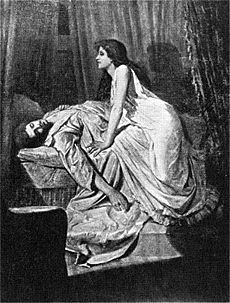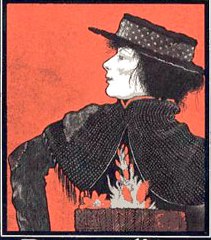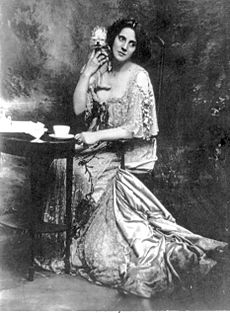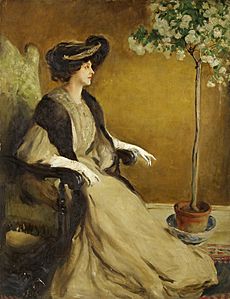Mrs Patrick Campbell facts for kids
Quick facts for kids
Mrs Patrick Campbell
|
|
|---|---|
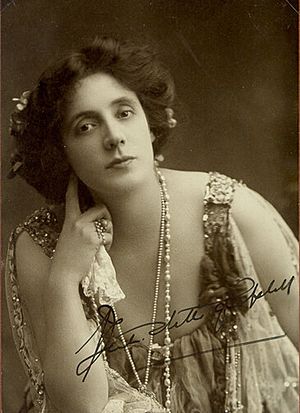 |
|
| Born |
Beatrice Rose Stella Tanner
9 February 1865 Kensington, London, England
|
| Died | 9 April 1940 (age 75) Pau, Pyrénées-Atlantiques, France
|
| Other names | Mrs Pat |
| Occupation | Actress |
| Years active | 1888–1935 |
| Spouse(s) |
Patrick Campbell
(m. 1884; died 1900)George Cornwallis-West
(m. 1914) |
| Children | 2 |
Beatrice Rose Stella Tanner (born February 9, 1865 – died April 9, 1940) was a famous English actress. Most people knew her by her stage name, Mrs Patrick Campbell or Mrs Pat. She was well-known for acting in plays by famous writers like Shakespeare, George Bernard Shaw, and J. M. Barrie. She also traveled to the United States to perform and even appeared in a few movies.
Contents
Early Life and Family
Beatrice Rose Stella Tanner was born in Kensington, London, England. Her father, John Tanner, came from a wealthy family. His father worked for the British East India Company. Her mother, Maria Luigia Giovanna Romanini, was from Italy. Her family had to leave Italy because of political reasons.
Beatrice studied music for a short time at the Guildhall School of Music.
Becoming a Stage Star
Mrs. Patrick Campbell started her acting career in 1888. This was four years after she married Patrick Campbell. She first performed in Liverpool, then in London. She became very famous after starring in the play The Second Mrs Tanqueray in 1893. She also had great success in other plays like The Masqueraders and The Notorious Mrs. Ebbsmith.
She performed with another famous actor, Johnston Forbes-Robertson, at the Lyceum Theatre in London. Together, they acted in many of Shakespeare's plays. She played important roles like Juliet in Romeo and Juliet, Ophelia in Hamlet, and Lady Macbeth in Macbeth. Mrs. Campbell also helped other actors, like Gerald Du Maurier, start their careers.
Broadway and Beyond
In 1900, Mrs. Campbell became her own manager. She made her first appearance on Broadway in New York City. She starred in the play Heimat and was a big hit. She continued to perform in New York and tour the United States until 1933.
Some of her other famous roles included:
- The Joy of Living (1902)
- Pelléas et Mélisande (1904), where she acted with her friend Sarah Bernhardt.
- Hedda Gabler (1907)
- Bella Donna (1911)
Pygmalion and Later Roles
In 1914, Mrs. Campbell played Eliza Doolittle in the first London production of Pygmalion. The famous writer George Bernard Shaw wrote this play especially for her. Even though she was 49 years old, she was amazing in the role. She took the play to New York in 1915 and performed it again in London in 1920.
Later in her career, she played the main role in Henrik Ibsen's play Hedda Gabler in 1922. She also acted in Ghosts in 1928 with John Gielgud. Her last big stage role was in the play A Party on Broadway. In her later years, she also appeared in a few films. These included One More River (1934) and Crime and Punishment (1935).
Relationship with George Bernard Shaw
Mrs. Patrick Campbell became known to George Bernard Shaw in the late 1890s. Shaw was a well-known theater critic. He often praised her best performances and criticized her weaker ones. Shaw was inspired by her for some of his plays even before they met.
They first met in 1897. Shaw tried to get her to act in his play The Devil's Disciple, but it didn't work out. In 1912, they started talking about the play Pygmalion. Shaw became very interested in Mrs. Campbell. They had a close friendship and exchanged many letters.
Mrs. Campbell ended their close relationship, even though Shaw was directing her in Pygmalion. They remained friends, but Shaw never again offered her the main roles he wrote with her in mind. After Shaw's death, most of their letters were published in 1952.
Famous Sayings
Mrs. Campbell was known for her quick and clever remarks. One of her most famous sayings was: "My dear, I don't care what they do, so long as they don't do it in the street and frighten the horses."
Another time, at a dinner, she sat next to a scientist who kept talking about ants. He said, "They even have their own police force and army!" She quickly replied, "No navy?"
Personal Life
In 1884, Beatrice married Patrick Campbell. They had two children, Alan "Beo" Urquhart Campbell and Stella Campbell. Patrick's health was not good, and he traveled a lot. He went to Australia and South Africa for several years. He did not send much money home.
In 1900, Patrick went to South Africa to fight in the Second Boer War. He was killed in battle on April 5, 1900.
Her son, Beo, became an actor and toured with his mother. Her daughter, Stella, also acted with her mother in the United States.
In 1909, Mrs. Campbell met George Cornwallis-West. They married on April 6, 1914. Even after her second marriage, she continued to use her stage name, "Mrs Patrick Campbell."
Mrs. Patrick Campbell passed away on April 9, 1940, in Pau, France. She was 75 years old and died from pneumonia.
Legacy and Recognition
Many of Mrs. Campbell's writings and letters are kept in special collections at universities. These include the University of Birmingham and Harvard University. Her letters to George Bernard Shaw are also very important.
A book called Mrs. Pat: The Life of Mrs. Pat Campbell was written about her life in 1984. In 2015, a play about her, called Mrs. Pat, was performed in England. It starred the famous actress Dame Penelope Keith.
Filmography
| Year | Title | Role | Notes |
|---|---|---|---|
| 1920 | The Money Moon | ||
| 1930 | The Dancers | Aunt Emily | |
| 1934 | Riptide | Aunt Hetty | |
| 1934 | One More River | Lady Mont | |
| 1934 | Outcast Lady | Lady Eve | |
| 1935 | Crime and Punishment | Pawnbroker | (final film role) |
See also
 In Spanish: Mrs. Patrick Campbell para niños
In Spanish: Mrs. Patrick Campbell para niños


